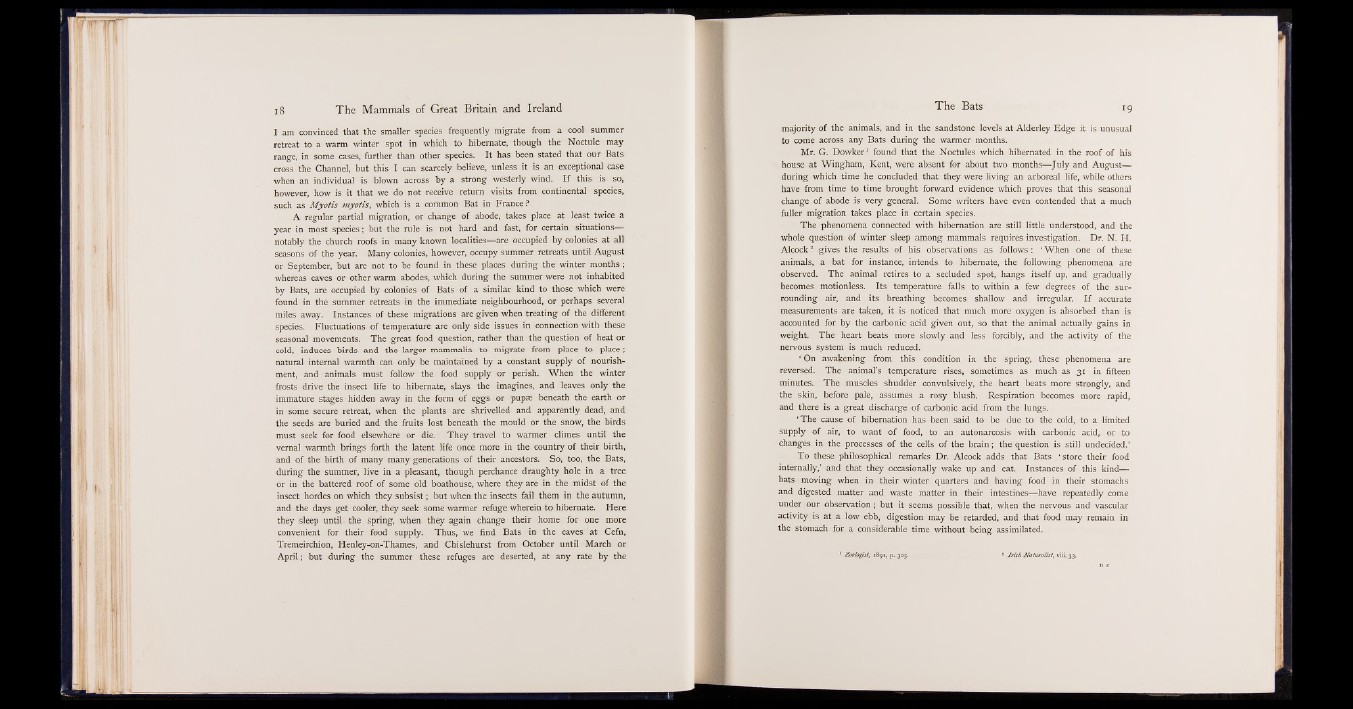
I am convinced that the smaller species frequently migrate from a cool summer
retreat to a warm winter spot in which to hibernate, though the Noctule may
range, in some cases, further than other species. It has been stated that our Bats
cross the Channel, but this I can scarcely believe, unless it is an exceptional case
when an individual is blown across by a strong westerly wind. If this is so,
however, how is it that we do not receive return visits from continental species,
such as Myotis myotis, which is a common Bat in France ?
A regular partial migration, or change of abode, takes place at least twice a
year in most species; but the rule is not hard and fast, for certain situations—
notably the church roofs in many known localities— are occupied by colonies at all
seasons of the year. Many colonies, however, occupy summer retreats until August
or September, but are not to be found in these places during the winter months;
whereas caves or other warm abodes, which during the summer were not inhabited
by Bats, are occupied by colonies of Bats of a similar kind to those which were
found in the summer retreats in the immediate neighbourhood, or perhaps several
miles away. Instances of these migrations are given when treating of the different
species. Fluctuations of temperature are only side issues in connection with these
seasonal movements. The great food question, rather than the question of heat or
cold, induces birds and the larger mammalia to migrate from place to place;
natural internal warmth can only be maintained by a constant supply of nourishment,
and animals must follow the food supply or perish. When the winter
frosts drive the insect life to hibernate, slays the imagines, and leaves only the
immature stages hidden away in the form of eggs or pupae beneath the earth or
in some secure retreat, when the plants are shrivelled and apparently dead, and
the seeds are buried and the fruits lost beneath the mould or the snow, the birds
must seek for food elsewhere or die. They travel to warmer climes until the
vernal warmth brings forth the latent life once more in the country of their birth,
and of the birth of many many generations of their ancestors. So, too, the Bats,
during the summer, live in a pleasant, though perchance draughty hole in a tree
or in the battered roof of some old boathouse, where they are in the midst of the
insect hordes on which they subsist; but when the insects fail them in the autumn,
and the days get cooler, they seek some warmer refuge wherein to hibernate. Here
they sleep until the spring, when they again change their home for one more
convenient for their food supply. Thus, we find Bats in the caves at Cefn,
Tremeirchion, Henley-on-Thames, and Chislehurst from October until March or
April; but during the summer these refuges are deserted, at any rate by the
majority of the animals, and in the sandstone levels at Alderley Edge it is unusual
to come across any Bats during the warmer months.
Mr. G. Dowker1 found that the Noctules which hibernated in the roof of his
house at Wingham, Kent, were absent for about two months— July and August—
during which time he concluded that they were living an arboreal life, while others
have from time to time brought forward evidence which proves that this seasonal
change of abode is very general. Some writers have even contended that a much
fuller migration takes place in certain species.
The phenomena connected with hibernation are still little understood, and the
whole question of winter sleep among mammals requires investigation. Dr. N. H.
Alcock2 gives the results of his observations as follows: ‘When one of these
animals, a bat for instance, intends to hibernate, the following phenomena are
observed. The animal retires to a secluded spot, hangs itself up, and gradually
becomes motionless. Its temperature falls to within a few degrees of the surrounding
air, and. its breathing becomes shallow and irregular. If accurate
measurements are taken, it is noticed that much more oxygen is absorbed than is
accounted for by the carbonic acid given out, so that the animal actually gains in
weight. The heart beats more slowly and less forcibly, and the activity of the
nervous system is much reduced.
‘ On awakening from this condition in the spring, these phenomena are
reversed. The animal’s temperature rises, sometimes as much as 31 in fifteen
minutes. The muscles shudder convulsively, the heart beats more strongly, and
the skin, before pale, assumes a rosy blush. Respiration becomes more rapid,
and there is a great discharge of carbonic acid from the lungs.
‘ The cause of hibernation has been said to be due to the cold, to a limited
supply of air, to want of food, to an autonarcosis with carbonic acid, or to
changes in the processes of the cells of the brain; the question is still undecided.’
To these philosophical remarks Dr. Alcock adds that Bats ‘ store their food
internally,’ and that they occasionally wake up and eat. Instances of this kind—
bats moving when in their winter quarters and having food in their stomachs
and digested matter and waste matter in their intestines— have repeatedly come
under our observation; but it seems possible that, when the nervous and vascular
activity is at a low ebb, digestion may be retarded, and that food may remain in
the stomach for a considerable time without being assimilated.
1 Zoologist, 1891, p. 305. 2 Irish Naturalist, viii. 33-